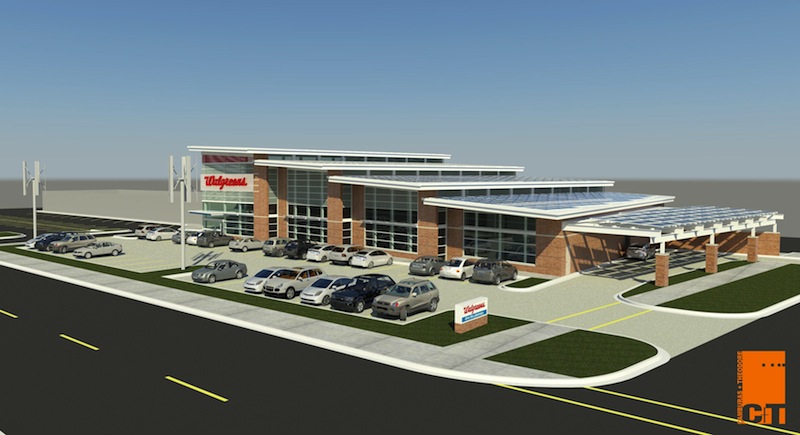Walgreens announced plans last week to build one of the nation's first net-zero retail stores. The Evanston, Ill., location will utilize solar panels, wind turbines, geothermal technology, LED lighting and ultra-high-efficiency refrigeration to produce energy equal to or greater than the building consumes.
The Chicago-area location will allow convenient access for Walgreens engineers based at the company’s headquarters in Deerfield, Ill., to measure the store’s performance for an entire year to determine if the store reaches its goal of net zero energy use.
Walgreens plans to generate electricity and reduce its usage by more than 40 percent through several technologies in the store including:
- more than 800 roof-top solar panels
- two wind turbines
- geothermal energy obtained by drilling 550-feet into the ground below the store, where temperatures are more constant and can be tapped to heat or cool the store in winter and summer
- LED lighting and daylight harvesting
- carbon dioxide refrigerant for heating, cooling and refrigeration equipment
- energy efficient building materials.
Engineering estimates--which can vary due to factors such as weather, store operations and systems performance- indicate that the store will use 200,000 kilowatt hours per year of electricity while generating 256,000 kilowatt hours per year.
Over the past year, Walgreens engineers have worked with the city of Evanston and vendors, including Trane, CREE Lighting, Acuity Lighting, Cooper Lighting, CalStar Products, GE Lighting, Geothermal International, SoCore Energy, Wing Power and Camburas and Theodore Architects.
(http://news.walgreens.com/article_display.cfm?article_id=5717)
Related Stories
| Aug 11, 2010
PBK, DLR Group among nation's largest K-12 school design firms, according to BD+C's Giants 300 report
A ranking of the Top 75 K-12 School Design Firms based on Building Design+Construction's 2009 Giants 300 survey. For more Giants 300 rankings, visit http://www.BDCnetwork.com/Giants
| Aug 11, 2010
AGC unveils comprehensive plan to revive the construction industry
The Associated General Contractors of America unveiled a new plan today designed to revive the nation’s construction industry. The plan, “Build Now for the Future: A Blueprint for Economic Growth,” is designed to reverse predictions that construction activity will continue to shrink through 2010, crippling broader economic growth.
| Aug 11, 2010
High-profit design firms invest in in-house training
Forty-three percent of high-profit architecture, engineering, and environmental consulting firms have in-house training staff, according to a study by ZweigWhite. The 2008-2009 Successful Firm Survey reports that only 36% of firms overall have in-house training staff. In addition, 52% of high-profit firms use an online training system or service.
| Aug 11, 2010
Report: Fraud levels fall for construction industry, but companies still losing $6.4 million on average
The global construction, engineering and infrastructure industry saw a significant decline in fraud activity with companies losing an average of $6.4 million over the last three years, according to the latest edition of the Kroll Annual Global Fraud Report, released today at the Association of Corporate Counsel’s 2009 Annual Meeting in Boston. This new figure represents less than half of last year’s amount of $14.2 million.
| Aug 11, 2010
Davis Langdon, DEGW merge
Leading global construction consultancy Davis Langdon and strategic planning consultants DEGW have announced a merger







